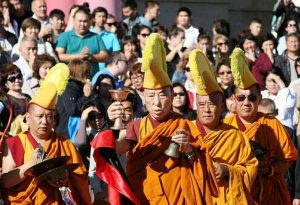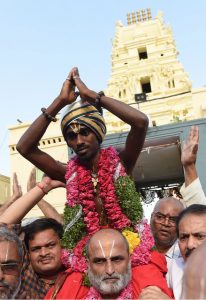
The teachings of Pure Land Buddhism are easy to practice but difficult to believe in
At the end of the Amitabha Sutra, Shakyamuni Buddha observes that his discourses on Amitabha Buddha and the Pure Land are the most difficult of all his teachings to believe in. However, in Chapter on the Easy Path, the bodhisattva Nagarjuna, the de facto founder of Pure Land Buddhism in India, says that Pure Land Buddhism is the easiest of all Mahayana teachings to practice. These two statements are not contradictory, but underline the fact that the teachings of Pure Land Buddhism are easy to practice but difficult to believe in.
Pure Land teachings are easy to practice because, in order to embark on the journey to Buddhahood, the practitioner is required only to exclusively invoke the name of Amitabha Buddha—“Namo Amitabha”—as his sole practice. Pure Land teachings are difficult to believe in because the practitioner must believe in the power of Amitabha’s vow in order to be reborn in the Land of Bliss; he must let go of the imperative to “make merit” and transfer it towards the attainment of his spiritual goals. To someone deeply invested in self-powered forms of practice this can feel like abandoning the religious quest, but by believing wholeheartedly in deliverance through Amitabha, the practitioner can attain liberation from reincarnation, achieve the state of non-retrogression, and attain Buddhahood.
As discussed in my previous articles, there are three modes of belief in religious teachings for ordinary people: belief through direct experience (factual evidence), through irrefutable deduction (analytic interpretation), or through testimony worthy of confidence (the teachings of a sage). Therefore, Shakyamuni Buddha takes three different approaches in the Pure Land sutras to convince people to believe in and accept Amitabha’s deliverance. Ultimately, he aims to trigger our belief in, and aspiration for, rebirth through the exclusive practice of Amitabha-recitation.
Sutra-based evidence
Ordinary beings, especially in our modern age, are generally skeptical when it comes to metaphysics, and it is fashionable to challenge the credibility of any teachings that are difficult to believe in, such as those of Pure Land Buddhism. In response to this doubt, Buddhists generally deploy three categories of evidence: evidence based on sutras, evidence based on commentaries, and evidence based on accounts. (It should be noted that these three categories parallel the three modes of belief mentioned earlier.)
Among the three categories of evidence, Pure Land Buddhism considers sutra-based evidence to be the most important. For example, the central teaching of the Pure Land School is that the main cause for rebirth in Amitabha’s Pure Land is the exclusive practice of Amitabha-recitation. Upon hearing this, someone may ask, “Who says so? Alan Kwan?” To which someone may reply, “Oh, Alan Kwan is not qualified to make such a statement; don’t trust him.” However, if these are golden words from the mouth of Shakyamuni Buddha, the reply is likely to be very different. Hence, it is important for practitioners to quote or reference the Pure Land sutras spoken by Shakyamuni when explaining the Pure Land teachings to others.
To demonstrate this point, the above teaching is outlined clearly in Amitabha’s 18th Vow in the Infinite Life Sutra. It is also the concluding statement of the Contemplation Sutra and the core teaching concerning rebirth in the Amitabha Sutra. Shakyamuni Buddha, being the wisest, kindest, and most trustworthy person in human history, delivered these three sutras. For this reason, evidence from the Pure Land sutras is an important element in convincing people to believe in the Pure Land teachings. This is akin to belief through “testimony worthy of confidence.”
In his discussion of the concept of establishing faith, Master Shandao says: “I sincerely advise all those who have the karmic conditions to aspire to rebirth [in the Land of Bliss] to deeply believe in the Buddha’s words alone, and to concentrate on strictly following his teachings. Do not believe in and follow any other bodhisattva’s teachings, as they are incompatible [with Amitabha’s Pure Land teachings]. Such teachings may hinder you by giving rise to doubts, lead you into a maze of confusion, and eventually cause you to abandon and lose the great benefit of rebirth [in the Land of Bliss].” Master Shandao reminds Pure Land practitioners not to believe in or follow the teachings of any other bodhisattva, but to exclusively follow the three Pure Land sutras spoken by Shakyamuni Buddha.
Commentary-based evidence
Shakyamuni Buddha mentions Amitabha Buddha in more than 200 sutras for different people in different circumstances and suffering from different karmic illnesses. His teachings are profound, and ordinary beings may not fully understand the concepts or even the terminology used in the sutras. How do we know that we correctly understand the Pure Land sutras?
The bodhisattva Nagarjuna, the bodhisattva Vasubandhu, Master Tanluan, and Master Shandao are respected patriarchs of Pure Land Buddhism. Abiding by Amitabha’s Fundamental Vow, they formed a lineage to transmit the definitive Pure Land teachings for posterity. In addition, they wrote commentaries on the sutras, analyzing and explaining their true meaning. Ordinary beings cannot hope to interpret the Pure Land sutras better than these eminent masters.
Intellectuals who enjoy analytical argumentation may put forth different interpretations of the Pure Land sutras, hence evidence based on the commentaries written by the Pure Land patriarchs is necessary to rebut their arguments and encourage them to believe. This approach to Pure Land teachings, based on reason and evidence, is similar to “belief by irrefutable deduction.”
Account-based evidence
Some people may ask, “Are there facts or examples to show us that one can be reborn in the Land of Bliss through the exclusive practice of Amitabha-recitation?” This is a good question. The easiest and most effective way to convince people to believe this is to give them examples or facts as proof. One account is better a thousand words. That is why hundreds of accounts of rebirth in the Land of Bliss through Amitabha-recitation have been published for circulation and used in the propagation of Pure Land Buddhism.
Hearing does not mean believing; believing does not mean having faith. Although it is important to provide evidence based on the three different categories discussed above, skeptics will still initially reject or balk at Pure Land teachings. In Buddhism, they are known as people with shallow roots of virtue. We will discuss this in detail in a later article.











